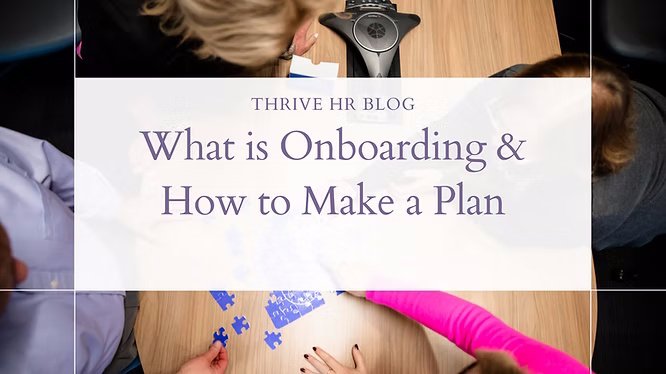What is Onboarding and How to Make a Plan
Imagine this: it’s your first day at a new job. After months of applying and enduring multiple interviews with various companies, you finally landed an offer at an organization that aligns with your personal goals and has a well-thought-out mission. You step into the company, eager to make the most of your first day. But instead of receiving a warm welcome or engaging training, your team lead sits you down at a computer, hands you a login code, and asks you to complete a generic training module—one that might not even relate to your day-to-day responsibilities.
What happened to the robust training program they mentioned during the interview? The team atmosphere they emphasized? How are you supposed to connect with your coworkers? And where, exactly, are you supposed to put your lunch?
Somewhere along the way, there’s been a disconnect. The company culture and mission that excited you during the hiring process seem distant now, leaving you to navigate this new environment on your own. You start questioning whether this job was really the right choice.
Unfortunately, this scenario is all too common for new hires. While it’s often not intentional or malicious, such an experience can significantly affect a company’s ability to retain employees, properly train them, and ensure their success.
As the job market evolves—with millennials assuming leadership roles and Gen Z employees seeking value-driven workplaces—it’s increasingly vital for organizations to establish a repeatable, effective onboarding process.
Why Onboarding Matters
To understand why onboarding matters, we first need to clarify what it entails. In human resources, onboarding is the process of integrating a new employee into an organization. But when we break this down further, it involves familiarizing the new hire with several key areas of the company, such as:
Mission and Values: Helping employees connect with the company’s purpose and guiding principles.
Company Culture: Demonstrating how things are done and how the team operates.
Specific Job Duties: Clarifying responsibilities and expectations for the role.
Management and Team Introductions: Building relationships with direct managers and team members.
Policies and Procedures: Providing an understanding of guidelines, compliance, and workflows.
Each of these areas requires thoughtful, repeatable processes to ensure a consistent onboarding experience. A structured onboarding program helps new employees feel like part of the team, understand their role, and maintain their excitement about joining the organization, keeping them engaged and productive.
Creating an Effective Onboarding Plan
An effective onboarding plan is a comprehensive process designed to ensure that new employees integrate seamlessly into the organization. Each component of the onboarding plan plays a specific role in fostering engagement, productivity, and a sense of belonging.
Pre-Boarding: Pre-boarding begins before the employee’s first day and sets the tone for their experience. It involves preparing for their arrival by ensuring all logistics are in place, such as their workspace, tools, and access to necessary systems. This phase may also include sending a welcome email, providing introductory materials like a company handbook, and sharing their first-day schedule. Pre-boarding helps ease first-day nerves and demonstrates the company’s commitment to a smooth transition.
Orientation: Orientation is the official introduction to the organization and typically occurs on the employee’s first day or week. It includes an overview of the company’s mission, values, culture, policies, and history. Orientation helps employees understand the big picture and how their role contributes to the organization’s success. It’s also an opportunity to communicate expectations and familiarize them with key workplace processes and etiquette.
Role-Specific Training: This component focuses on equipping the new hire with the knowledge and skills they need to excel in their role. It includes job-specific instructions, tools, and workflows tailored to their responsibilities. Training may involve hands-on learning, job shadowing, or e-learning modules. The goal is to provide clarity and confidence in their day-to-day tasks while reinforcing their alignment with team goals.
Cultural Integration: Cultural integration is about helping employees feel connected to the organization and their colleagues. This includes introductions to team members, participation in team-building activities, and exposure to the company’s traditions and unwritten norms. A strong focus on cultural integration helps foster a sense of belonging and encourages employees to build meaningful relationships within the organization.
Ongoing Engagement: Onboarding doesn’t end after the first week. Ongoing engagement involves regular check-ins, feedback sessions, and opportunities for growth over the employee’s first few months. It includes setting clear goals and milestones, providing consistent communication, and addressing any concerns or questions. Ongoing engagement ensures that new hires remain motivated and supported as they settle into their roles.
Feedback and Adjustment: A successful onboarding plan includes opportunities for feedback from new employees about their experience. This feedback helps organizations refine and improve their onboarding processes. Gathering insights about what worked well and what could be improved demonstrates the company’s commitment to continuous improvement and employee satisfaction.
A strong onboarding program is more than just a welcome—it’s the foundation for an employee’s success and a company’s long-term growth. By implementing a structured and thoughtful process, organizations ensure new hires feel valued, prepared, and excited to contribute. From pre-boarding to ongoing engagement, each phase plays a critical role in building trust, fostering a sense of belonging, and aligning employees with the company’s mission and values.
As the workforce evolves, effective onboarding becomes an essential tool for attracting and retaining top talent. Companies that invest in this process not only empower their employees but also cultivate a culture of engagement, productivity, and loyalty. By prioritizing onboarding, businesses can turn the first day into the first step toward lasting success—for both the employee and the organization.

